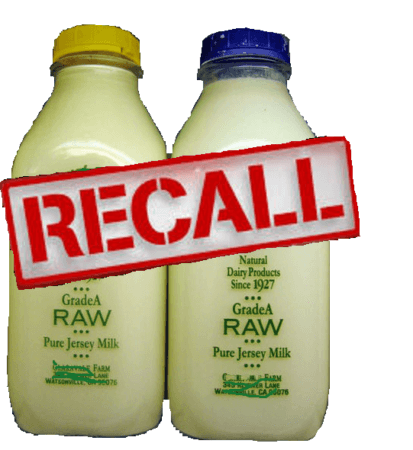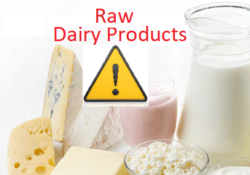Consumption of Unpasteurized Cow’s Milk and Cheese and its Impact on Outbreaks and Diseases
Introduction
 Despite of everything we learned about the danger of raw milk and its products, the sales of raw or unpasteurized milk and milk products are still legal in at least 30 states in the United States. Raw milk and milk products from cows, goats, and sheep continue to be a source of bacterial infections attributable to a number of virulent pathogens, including Listeria monocytogenes, Campylobacter jejuni, Salmonella species, Brucella species, and Escherichia coli O157.
Despite of everything we learned about the danger of raw milk and its products, the sales of raw or unpasteurized milk and milk products are still legal in at least 30 states in the United States. Raw milk and milk products from cows, goats, and sheep continue to be a source of bacterial infections attributable to a number of virulent pathogens, including Listeria monocytogenes, Campylobacter jejuni, Salmonella species, Brucella species, and Escherichia coli O157.
A report published in Emerging Infectious Diseases, Volume 23, Number 6—June 2017 by Solenne Costard , et,al. stated that the growing popularity of unpasteurized milk in the United States raised public health concerns. The authors estimated the impact of outbreak-related illnesses and hospitalizations caused by the consumption of cow’s milk and cheese contaminated with Shiga toxin–producing Escherichia coli, Salmonella spp., Listeria monocytogenes, and Campylobacter spp. by using a model relying on publicly available outbreak data.
The trend towards increased availability of unpasteurized dairy products raises public health concerns, especially since raw milk consumers include children.
Why Raw Milk
Consumers are increasingly demanding more natural and organic foods (i.e., minimally processed foods). Following a similar trend the popularity of unpasteurized milk in the U.S. has been growing as well. Advocates of raw milk claim that it is rich in beneficial bacteria, natural vitamins and food enzymes. Many small-scale and local dairy farmers also strongly support the raw milk movement, as do many natural health advocates.
Raw milk enthusiasts claim that the products taste better, produce fewer allergic reactions and can cure illnesses — claims that are all anecdotal and unproven. Consumers also point out that raw milk tends originate from family farms rather than “factory farms”.
Efforts to limit the sale of raw milk products have met with opposition from those who are advocates of the alleged health benefits of consuming raw milk products, which contain natural or unprocessed factors not inactivated by pasteurization.
However, the increased consumption of raw milk and its products is raising public health concerns. This is because, in contrast to some perceptions, natural food products are not necessarily safer than conventional ones, as evidenced by higher rates of foodborne illnesses associated with unpasteurized dairy products.
The CDC believes that “There are no health benefits from drinking raw milk that cannot be obtained from drinking pasteurized milk that is free of disease-causing bacteria. The process of pasteurization of milk has never been found to be the cause of chronic diseases, allergies, or developmental or behavioral problems.” and the CDC condemns its consumption.

The Study
In the study a total of 87 outbreaks causing 750 laboratory-confirmed illnesses and 215 hospitalizations were considered. The incidence rates of STEC, Salmonella spp., and Campylobacter spp. illnesses and hospitalizations per 1 billion servings were higher for unpasteurized dairy product consumers than for pasteurized dairy product consumers. Illnesses and hospitalizations caused by L. monocytogenes infections which were more often attributed to the consumption of pasteurized cheese than unpasteurized cheese.
The authors calculated that if the percentage of unpasteurized milk consumers in the United States were to increase to 3.8% and unpasteurized cheese consumers to 1.9% (i.e., an increase of 20%), the number of illnesses per year would increase by an average of 19% and the number of hospitalizations by 21%.
If the percentages of unpasteurized milk and cheese consumers were to double, the number of illnesses would increase by an average of 96%, and the number of hospitalizations would increase by 104%, resulting in additional 733 illnesses/year and 22 hospitalizations/year, which correspond to a total of 1,493 illnesses/year mostly caused by Salmonella spp. and Campylobacter spp.
In this study bulk milk tanks on US raw milk farms has been found to contain STEC in 2.5% of the cases, Salmonella spp. in 4.6%, L. monocytogenes in 2.5%, and Campylobacter spp. in 4.7% of the cases.
The Take-Home Message
In the US outbreaks associated with dairy consumption cause on average 760 illnesses/year and 22 hospitalization/year, caused mostly by Salmonella spp., and Campylobacter spp. While unpasteurized milk is consumed by only 3.2% of the population, and cheeses from unpasteurized milk by only 1.6% of the population, they caused 96% of the illnesses caused by dairy products. This result means that unpasteurized dairy products cause 840 times more illnesses and 45 times more hospitalizations than pasteurized dairy products.
Despite a decrease in dairy consumption in the United States, recent studies suggest that over the past 15 years the number of outbreaks associated with unpasteurized dairy products has increased.
The authors state that as consumption of unpasteurized dairy products grows, illnesses will increase steadily; a doubling in the consumption of unpasteurized milk or cheese could increase outbreak-related illnesses by 96%.
Consequently, those who consume raw milk are taking chances with their health since consuming raw milk increases the chances of getting an outbreak-related illness by more than 800 times.
